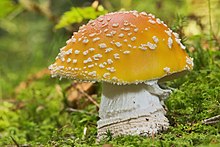| Agaricomycetes Temporal range:
| |
|---|---|

| |
| Amanita muscaria (Agaricales) | |
| Scientific classification | |
| Domain: | Eukaryota |
| Kingdom: | Fungi |
| Division: | Basidiomycota |
| Subdivision: | Agaricomycotina |
| Class: | Agaricomycetes Doweld (2001)[1] |
| Subclasses/orders | |
incertae sedis (no subclass)
| |
The Agaricomycetes are a class of fungi in the division Basidiomycota. The taxon is roughly identical to that defined for the Homobasidiomycetes (alternatively called holobasidiomycetes) by Hibbett & Thorn,[2] with the inclusion of Auriculariales and Sebacinales. It includes not only mushroom-forming fungi, but also most species placed in the deprecated taxa Gasteromycetes and Homobasidiomycetes.[3] Within the subdivision Agaricomycotina, which already excludes the smut and rust fungi, the Agaricomycetes can be further defined by the exclusion of the classes Tremellomycetes and Dacrymycetes, which are generally considered to be jelly fungi. However, a few former "jelly fungi", such as Auricularia, are classified in the Agaricomycetes. According to a 2008 estimate, Agaricomycetes include 17 orders, 100 families, 1147 genera, and about 21000 species.[4] Modern molecular phylogenetic analyses have been since used to help define several new orders in the Agaricomycetes: Amylocorticiales, Jaapiales,[5] Stereopsidales,[6] and Lepidostromatales.[7]
- ^ Cite error: The named reference
Doweld2001was invoked but never defined (see the help page). - ^ Cite error: The named reference
Hibbett2001was invoked but never defined (see the help page). - ^ Cite error: The named reference
Hibbett2007was invoked but never defined (see the help page). - ^ Cite error: The named reference
Kirk2008was invoked but never defined (see the help page). - ^ Cite error: The named reference
Binder 2010was invoked but never defined (see the help page). - ^ Cite error: The named reference
Sjökvist 2014was invoked but never defined (see the help page). - ^ Cite error: The named reference
Hodkinson 2014was invoked but never defined (see the help page).